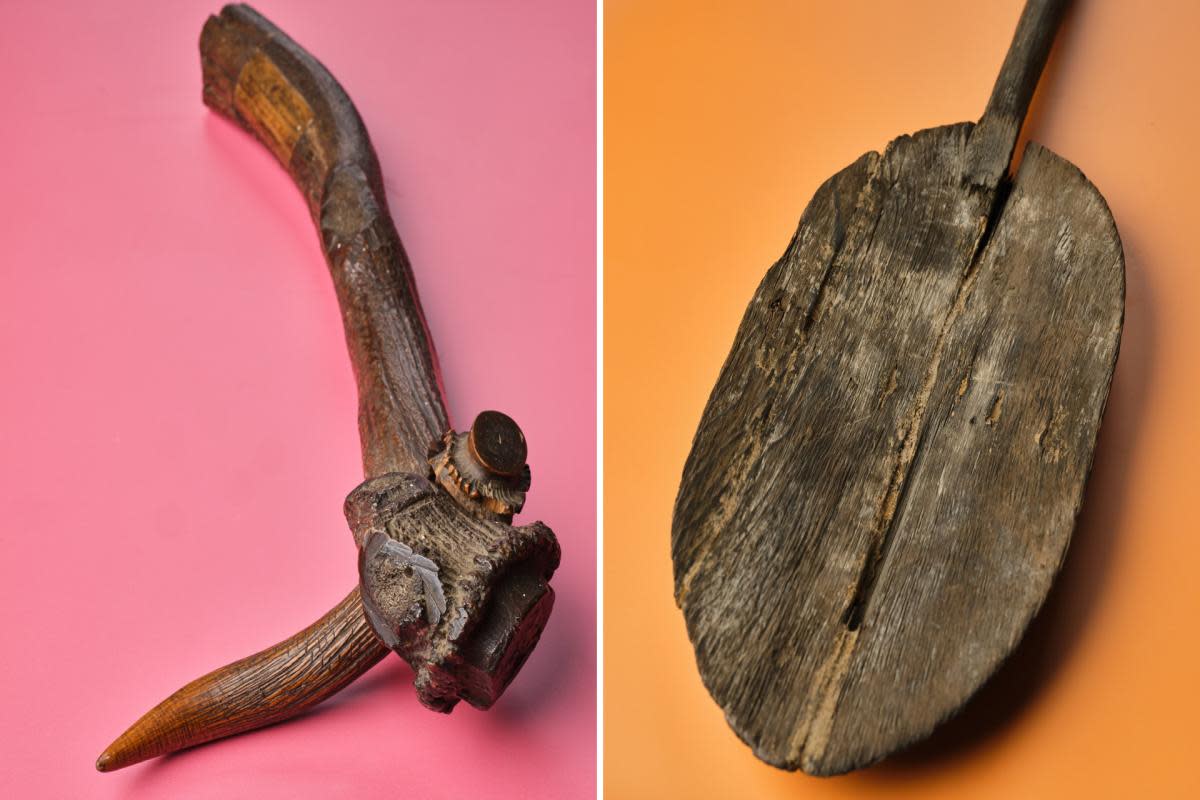Europe's oldest Bronze Age mining tools discovered in Cornwall to be displayed

In an exciting discovery, the Royal Cornwall Museum has revealed the existence of the oldest Bronze Age mining tools ever found in Europe.
The findings which date back more than 3,600 years ago, have been revealed ahead of the museum’s redesigned Mineral Gallery set to open in July 2024. The gallery will show the current understanding of prehistoric mining practices and highlight how Cornwall played a significant role in the early stages of European metalworking.
The oak wooden shovel is said to be around 3,200 years old (Image: Royal Cornwall Museum)
Recent carbon dating research on an Oak Shovel along with evidence from examination of an Antler Pick has signified that these two items within the museum’s archive are the first Bronze Age tin mining tools to be found in Europe.
The tools were discovered in the Carnon Valley, mid-Cornwall during the 19th century when alluvial tin stream works were being reworked in the 19th century. Alluvial time stream works is a shallow mining operation following streams with naturally occurring deposits of tin. The radiocarbon dating indicated that they were from the British Bronze Age (2400-800BC).
Led by Dr Alan Williams from the Department of Archaeology at Durham University, the Royal Cornwall Museum’s oak wooden shovel has most recently been radiocarbon dated at around 3,200 years old by the Project Ancient Tin Team, with a grant from the Royal Archaeological Institute.
Understood to be found in the Caron Valley in 1815, this design is formed from one piece of wood, unlike Medieval wooden shovels that are in two pieces.
The antler pick, measuring 48cm in length is estimated to be around 3,600 years old (Image: Royal Cornwall Museum)
The antler pick, measuring 48cm in length is estimated to be around 3,600 years old, or Early Bronze Age is the first evidence for the extraction of tin and/ or alluvial gold in the British Isles. Following examination of the tool by Dr Simon Timberlake from the Early Mines Research Group it was revealed that tally marks had been carved into the antler pick suggesting a system of recording work by prehistoric miners.
These discoveries provide crucial evidence of Bronze Age tin workings in Cornwall, demonstrating the mining techniques at this early stage. They also support the growing theory that Cornwall was a primary source of tin for the European Bronze Age.
Adding further weight to this theory, small amounts of gold found in the Carnon Valley have been chemically linked to the gold used in the famous Nebra Sky Disk, an artefact thought to be the world’s oldest map of the stars. The presence of Cornish gold and tin in this artefact discovered in Germany, suggests that Cornish prehistoric mining and trading practices may have pioneered the European Bronze Age.
The new Mineral Gallery will be a chance to celebrate the past and future of Cornish mining (Image: Royal Cornwall Museum)
Bryony Robins, artistic director for the Royal Cornwall Museum said: “Cornwall and mining are already intertwined, but this important discovery demonstrates just how long mining has been taking place in Cornwall, and how well developed some of the tools of the trade were, even at that time.
“The Mineral Gallery will share with our visitors the heritage of mining in Cornwall and present the world-renowned collection of rocks and minerals in a more accessible way. And, of course, the role that mining is continuing to play in Cornwall.”
Reopening in early July 2024, the new Mineral Gallery will be a chance to celebrate the past and future of Cornish mining, with the unveiling of this first phase of the museum’s transformation which continues into 2025.
This is just the start of an exciting new era for this 200-year-old institution - a centre of exploration, learning, and custodian of Cornish heritage - home to over one million artefacts.

 Yahoo News
Yahoo News 
